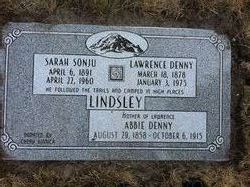In 1895, at age 18, Lindsley began working in the Esther Mine at the head of Gold Creek in Kittitas County. In 1899 he was employed by his grandfather, David T.Denny (who was contracted to oversee the work by King County) to help with the road repair of a wagon road across Snoqualmie Pass. It was at these two job sites that Lindsley began using his photography skills to document the work being done. In 1903, he started work at the W.P. Romans Photographic Company in Seattle, in which he owned part interest by the time it was purchased seven years later by Asahel Curtis. This led to Lindsley helping to develop some of the gold tone negatives for Edward S. Curtis' famous "Indians of North America" series. He was a charter member of the Mountaineers Club which formed in 1907. By 1908, he had moved to Lake Chelan and was working for the Great Northern Railroad, who hired him to photograph Glacier National Park for their tourist literature. Lindsley, an outdoorsman who learned to hunt deer on the summit of Queen Anne Hill, also worked as a wilderness guide.
In September 1916, the GNR hired Lindsley to be the guide, cook, and packer for the party of author Mary Roberts Rinehart. In Rinehart's published account of the expedition in Cosmopolitan magazine and in Tenting To-Night, her 1918 novel based in the Cascades, the taciturn Lindsley figured prominently as a character called, "Silent Lawrie." Lindsley himself was a prolific writer who kept journals for most of his adult life. He also wrote lengthy descriptions on the backs of many of his photographs, adding history, context, and detail to bring his pictures to life. He returned to Seattle and the Curtis Studio in 1916, living in the Wallingford District for over fifty years, and continued taking photographs into his 90's.
In 1895, at age 18, Lindsley began working in the Esther Mine at the head of Gold Creek in Kittitas County. In 1899 he was employed by his grandfather, David T.Denny (who was contracted to oversee the work by King County) to help with the road repair of a wagon road across Snoqualmie Pass. It was at these two job sites that Lindsley began using his photography skills to document the work being done. In 1903, he started work at the W.P. Romans Photographic Company in Seattle, in which he owned part interest by the time it was purchased seven years later by Asahel Curtis. This led to Lindsley helping to develop some of the gold tone negatives for Edward S. Curtis' famous "Indians of North America" series. He was a charter member of the Mountaineers Club which formed in 1907. By 1908, he had moved to Lake Chelan and was working for the Great Northern Railroad, who hired him to photograph Glacier National Park for their tourist literature. Lindsley, an outdoorsman who learned to hunt deer on the summit of Queen Anne Hill, also worked as a wilderness guide.
In September 1916, the GNR hired Lindsley to be the guide, cook, and packer for the party of author Mary Roberts Rinehart. In Rinehart's published account of the expedition in Cosmopolitan magazine and in Tenting To-Night, her 1918 novel based in the Cascades, the taciturn Lindsley figured prominently as a character called, "Silent Lawrie." Lindsley himself was a prolific writer who kept journals for most of his adult life. He also wrote lengthy descriptions on the backs of many of his photographs, adding history, context, and detail to bring his pictures to life. He returned to Seattle and the Curtis Studio in 1916, living in the Wallingford District for over fifty years, and continued taking photographs into his 90's.
Inscription
"He followed the trails and camped in high places."
Family Members
Sponsored by Ancestry
Advertisement
Explore more
Sponsored by Ancestry
Advertisement










